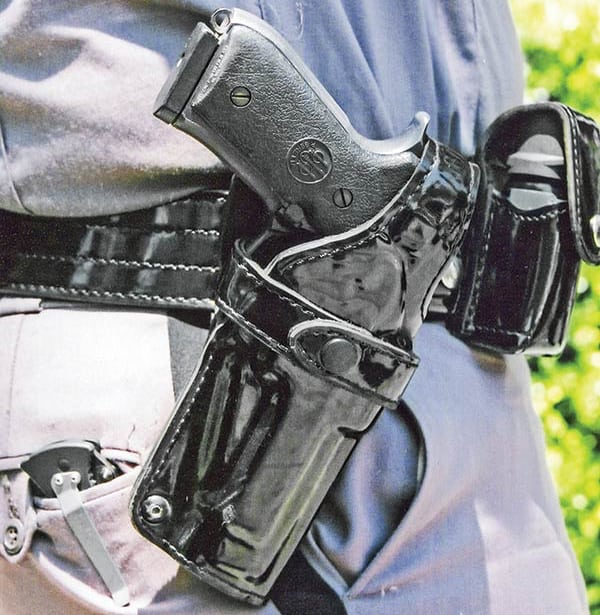Surviving Disarming Attempts
Old cops give young cops a warning: “Every time you’re in a fight, there’s a loaded gun present. Yours.”
If you aren’t prepared to counter a gungrab, you aren’t really prepared. One factor to consider is a sidearm that is “proprietary to the legitimate user.”
In an article on police firearms training, Jim Nesbitt of the Newhouse News Service wrote the following for the 9-10-’01 “New Orleans Times-Picayune”:
She ripped the semiautomatic out of his holster, stuck it in his face, and pulled the trigger — and Wayne Dobbs knew there was only one reason his life didn’t end in a flash of brain, bone and blood. The mentally unbalanced woman had failed to flick off the thumb safety of Dobbs’ cocked-and-locked .45-caliber pistol.
On that New Year’s Eve 20 years ago, this not-always-reliable mechanical device was the difference between being dead and being scared to death. Staring down the barrel of his own gun, Dobbs, then a 23-year-old patrol officer with a suburban Dallas police department, had this thought: “This is it. I’m finished.”
After he wrestled the gun away and had the woman safely handcuffed, he had another thought: “I’m not nearly as squared away with this as I need to be.” The harrowing moment transformed Dobbs into a relative rarity in American law enforcement, a true believer in the notion that he needed training beyond the police academy and the bloodless calm of the gun range.
Whew. Scary, huh? Now you’re seeing one reason why I’ve always been a believer in carrying an on-safe gun.
Wayne Dobbs went on to become a superb firearms instructor and master police officer. Last time I saw him, he was carrying the weapon his department saw fit to issue: a high-capacity .40-caliber pistol with no safety catch.
Retention Holsters
Decades ago, Bill Rogers designed the SS-III security holster, which became known as the first police scabbard with “Level III security” because three movements (release one strap, release the other, rock the gun in a certain direction) were necessary to clear leather. It was subsequently offered by Safariland as the Model 070, and more than a million of them have been sold since to uniformed police and security personnel.
In 20 years and 1,000,000 holsters, I’m not aware of a single case of a cop being disarmed and killed with his or her own weapon out of a Rogers/Safariland SS-III/070 holster. A few years ago, Safariland came out with the 0701, a holster suitable for concealed carry that has two out of three of the retention features that made the 070 such a successful life-saver. I’m not aware of a gun being snatched out of one of these holsters, either. Any lawabiding armed citizen can purchase an 0701 from a Safariland dealer.
Is a retention holster tougher for you to draw from? Sure. It requires more practice. Is it worth the effort? The facts speak for themselves with a resounding YES!
Just because you’re a private citizen carrying concealed, don’t think that you won’t experience a felonious gun-grab. The gun might become visible and trigger the grab. The bad guy may be a disgruntled employee who knows where you carry your gun. The situation may start with a hand-to-hand fight in which he grabs you around the waist and feels your gun!
Retention Skills
While working as a taxi driver, Mark Yuhr was forced to kill a hold-up man. The perp tried to shoot him with a stolen S&W 9mm whose original owner had left it onsafe. When the gunman pulled the trigger on Yuhr, nothing happened. Yuhr drew his cocked-and-locked Colt .45 auto — he knew where his safety was — and cut down his attacker. It then occurred to Yuhr that he should sharpen his survival skills, and he enrolled in my LFI-I class. He liked it and took the follow-up class, LFI-II, which goes heavy into weapon retention skills, i.e., the physical techniques you can use to counter a disarming attempt.
When working as a security guard, Yuhr had to carry a revolver with no safety catch. On one occasion, he found himself struggling with two perpetrators trying to snatch his duty Ruger. Yuhr used the techniques he had learned in the class, countered the attack, and survived.
He used a technique developed by Jim Lindell, the master of handgun retention who developed his system while teaching Kansas City cops. Such training is normally available only to police, through National Law Enforcement Training Center. The Lindell method, by far the most proven, is taught to civilians nationwide by the Massad Ayoob Group as well.
The possibility of being killed with your own gun is very real. A proprietary weapon, a security holster, and well-honed gun retention training — not necessarily in that order — have all been proven to save lives. Body armor and second weapons are also important elements in situations like these.
The officers in my department go on duty with Ruger .45 auto pistols that can be carried on safe. They are worn in department issue Safariland 070 holsters. Our department has adopted the Lindell method of handgun retention training.
I won’t lose sleep tonight worrying about one of these officers being disarmed.

Sign up for the Personal Defense newsletter here:



